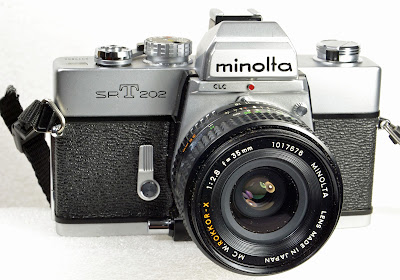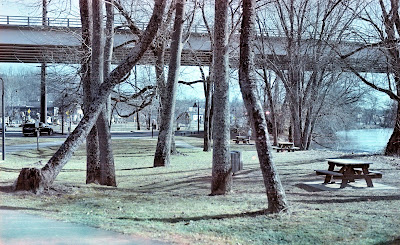 |
| My Minolta SRT 202 |
At risk of being thought of as a Nikon snob, it’s time to look at another SLR system that can still be found at a decent price. The Minolta SRT series features fully manual operation, the great “lollipop and stick” match-needle meter indicator, relatively robust construction, and the choice of lots of excellent Rokkor glass to choose from. The first SRT, the 101, appeared in 1966, replacing the SR series of SLRs. The T in SRT stands for TTL metering, and accordingly, the old SR-mount lenses were replaced with MC lenses, which are the same mount, but with the ability to transfer the aperture reading to the meter, via a tab on the base of the lens, much like Nikon’s AI lenses. While the SRT series was produced for over a decade, each iteration of models have slight improvements over the years. It was after these cameras that Minolta went to more electronics and automation, starting with the X series in the mid-70s.
The SRT 101, 102, 202 are all quite similar cameras, with the 202 being released in 1975. The last camera of the SRT series was the SRT 200, which was released in 1977, and it was much like its predecessor, the SRT 100, which was a cheaper version of the SRT 101, and lacked some of the features, with a 1/500 sec max shutter speed. The SRT 200’s max shutter speed was 1/1000 sec. All of the SRT models have a cloth, horizontally-traveling shutter curtain, match-needle metering, and required a 1.35v Mercury cell for the meter.
The thing to remember with the SRT series is that most of those cameras are now around 50 years old. Some of them may not have been treated kindly, and Minolta’s SLRs do not have the quality of build as say, a Nikon Nikkormat. The meters can operate with a modern 1.5V PX-625A cell, but you’ll need to compensate for the voltage difference by rating your film 1 stop slower - such as setting the ISO dial to 200 for 400 ISO film. You can also purchase an MR-9 battery adapter that reduces the voltage from a normal AG13 button cell which cost about $30, but can be used in any camera that requires a PX-625 cell. Beware of imitators- some are advertised as such, but do not reduce the voltage.
Once you have acquired a good working SRT202 or 102, you’ll be instantly surprised at how simple it is to operate. You use the meter in the viewfinder to align the “lollipop” with the “stick” - either by adjusting the aperture, the shutter speed, or both to what should be a satisfactory exposure. The lens is easily focused in the viewfinder, and once you are happy with the composition, press the shutter button after the film has been wound. This is really basic stuff, and if you use the camera for a couple of rolls of film, you will find it easier to operate each time. The beauty of the SRT 202 is that the aperture and shutter speed are both seen in the viewfinder, so you don’t have to look at the control knobs while adjusting for a proper exposure.
I highly recommend the 50mm f/1.4 lens, and if you find a 45mm f/2 Rokkor-X lens, get one. It’s sort of a pancake lens, takes up little space, and is a good all-around normal lens. My other choice, if you have been reading this blog, would be the 35mm f/2.8 Rokkor-X lens. Beyond that, whether you are going for wide-angle or telephoto, there’s plenty of lens choices in the MC and MD lens line. . I used to do a lot of macrophotography with my Minolta X-700, and Minolta’s macro accessories are some of the best that you’ll find.
Let’s get back to the SRT202 and its siblings.
The SRT 202 can meter with films with an ISO ranging from 6 to 1600. That is pretty impressive, as many SLRs from that period typically have a minimum ISO setting of 25. Of course, if you use an external meter, that may not matter much. Nonetheless, there are some very interesting low ISO films out there to try. If your camera’s meter is working properly, that really makes using the camera so much simpler. Remember to turn on the meter using the switch on the bottom of the camera. Turn it off when stowing the camera for any length of time.
Flash photography - any simple single-contact flash unit that uses the standard hot shoe or via a pc cord (x-sync) will allow you to take photographs using strobe flash. It really doesn’t matter who the manufacturer is, but Vivitar and Sunpak flashes work well, and there are a lot to choose from in the used market, for next to nothing. Auto-thyristor flashes are preferred, as they give off the proper amount of light for a particular ISO setting and aperture. The SRT 202 has a maximum flash sync speed of 1/60 sec (in red on the dial), so to use a flash, you would use a 1/60 sec or slower shutter speed.
The main thing with the SRT series is that they are relatively simple cameras to operate, and are excellent manual cameras. The thing to remember when buying used, is that they newest of them are nearly 50 years old, and not all of them were treated well by previous owners. The most common problems you’ll encounter are non-working light meters, jammed film advances, or inaccurate shutters. That doesn’t mean that every SRT will have problems, but when trying one out, those are key things to look for. If the meter isn’t working, that’s easily overcome, but the other problems are not. Having said that, I see far more X-series Minolta SLRs with problems, so stick with the all-manual SRTs.
The one feature that the SRT 202 lacks is mirror lockup - a feature that I have very rarely used. If you have your camera mounted securely on a tripod and are making Bulb exposures, using a cable release is a good idea. For 1 sec exposures and up, you could just use the self-timer to avoid shaking the camera. Mirror lockup is just one of those features that most of us never use.
 |
| The source for the manual images here |
The SRT cameras do not sell for a lot, so you should be able to purchase one on eBay in working condition at prices from $30 - $200, depending on whether the camera has been tested or not, etc. For $30 or less it might make sense to buy a camera that is “untested”, but some sellers actually are offering tested, repaired, and guaranteed SRT 202 cameras for about $180 - which seems pretty fair to me in light that there would not be any problems post-sale.
So, while yes, there are other camera brands out there, given the number of excellent Minolta lenses at decent prices, it makes sense to give a Minolta SRT 202, or 102, etc., a chance and see if it's the right fit for you.
 |
| The simplicity of the control layout is a plus. |
A few images from this camera, all with Kentmere 400:










































